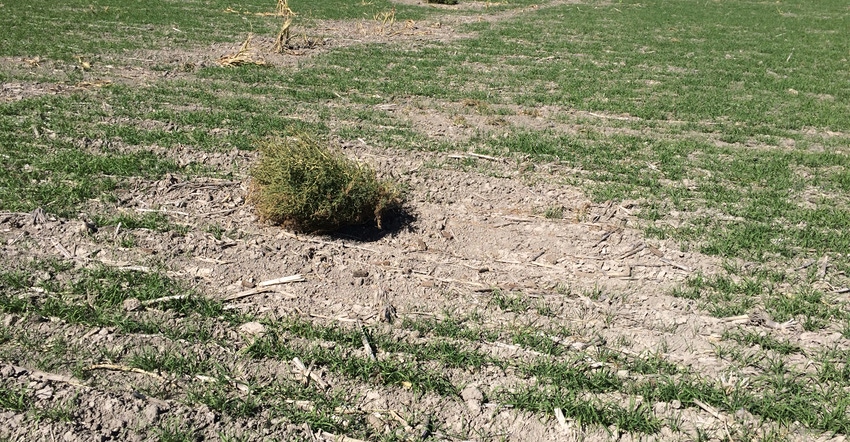
Stewardship is the way to win the fight to keep herbicides effective against stubborn weeds, and it is more important than ever as new accessions of resistant weeds emerge.
Kansas State University weed scientists have identified Kochia accessions from two different corn fields near Garden City in western Kansas that have developed multiple resistance to dicamba and fluroxypyr. Kochia in those two fields showed three to fifteenfold resistance to dicamba and four to eightfold resistance to fluroxypyr.
In addition, K-State Research Weed Scientist Vipan Kumar said there was one field near Hays that showed a four to fivefold resistance to dicamba and about a two to threefold resistance to fluroxypyr.
"These are the only three fields we are aware of that showed populations of dicamba and fluroxypyr, Kumar says. "We are currently planning to conduct a field survey in western Kansas to see if there is spread of this auxinic resistance."
Kochia with resistance to both dicamba and fluroxypyr was identified about four years ago in Nebraska. The discovery of auxinic resistance presents a management challenge because the resistant are also showing resistance to both glyphosate and atrazine.
Kumar says K-State test 10 different herbicides on the resistant populations and those that worked best are Gramoxone, Huskie, Brontate Advanced and Sharpen. He says additional greenhouse tests of other premixes including Scorch, Kochiavore, Talinor, and Starane NXT, but those results are not yet available.
Kochia is a troublesome weed all across the Great Plains states. It emerges very early in the spring, usually in February and March, but continues to emerge in flushes as late as July.
Controlling spread can be difficult because it produces more than 100,000 seeds per plant and the wind sends the mature plants tumbling over landscapes, spreading those seed as it grows. It draws a great deal of nitrogen from the soil, and causes significant crop yield losses, especially where it is present all season or in high density.
The first glyphosate-resistant Kochia in western Kansas was identified in 2007, and the use of auxinic herbicides such as dicamba, 2,4-D and fluroxypyr has increased dramatically since that time. Kansas fields are typically treated with three to four applications of a tank mixture of glyphosate with Banvel and 2,4-D to control weeds during summer fallow.
T.J. Binns, agronomic service representative with Syngenta, says farmers need to focus on prevention first and control second.
"If you control it as a seed, they can't become a weed," he says.
He says farmers have been using herbicides to attempt control on plants that are too large for them to be effective and that can play a role in resistance development.
"A lot of farmers don't want to hear it, but tillage is probably the best control of Kochia once it is too large for herbicide control. You need to do something to prevent those plants from putting on seeds because they do produce and spread an enormous amount of seed," he says.
For farmers who want to control weeds in post-harvest wheat stubble, cover crops can be of help, he says, but growing them comes with some problems.
"One of the best herbicides is shade," he says.
That makes cover crops helpful. But you have to keep in mind that some residual herbicides used on wheat may kill some cover crops. And you have to be aware of what herbicides will be used to burn down the cover crop and make sure that works with the next crop you plan to plant, he said.
Next spring, Binns recommends using dicamba and atrazine pre-emerge to thin the weed population and Acuron corn herbicide to help with the burndown.
"But make sure that you follow it with a residual post-emergence herbicide if you do see weeds coming up," Binns advises. "You want to get those weeds when the corn is small because at that stage the corn will use energy trying to out-compete the weeds that would otherwise be used to produce yield later in the season."
For soybeans, he recommends metribuzin as an early pre-emergence herbicide and a mixture of Gramoxone SL 2.0 herbicide and BroadAxe SC herbicide at planting to get early kill and provide residual for weeds that will germinate later in the season.
"We need to be proactive rather than reactive. The best control comes from preventing the weeds from coming up. If we can control the seed before it becomes a weed, that's a win," Binns says.
A final piece of advice Binns offered to producers worried about resistant Kochia: Don't focus so hard on Kochia that you forget about other problem weeds that tend to come later in the season.
"If you change your application timings to deal with Kochia and you forget you may be fighting Palmer amaranth down the road, you could be in trouble," he says. "You have to have a proactive plan for the whole season."
About the Author(s)
You May Also Like






